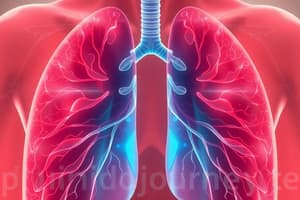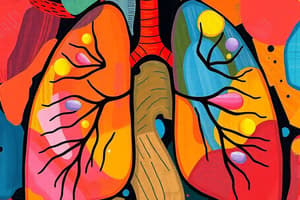Podcast
Questions and Answers
What are the two main parts of the air passages in the respiratory system?
What are the two main parts of the air passages in the respiratory system?
Conducting airway and respiratory tissues
Which cells line the wall of conducting airways and form a layer called mucociliary blanket?
Which cells line the wall of conducting airways and form a layer called mucociliary blanket?
Mucus-secreting gland cells
What is the function of ciliated cells in the conducting airways?
What is the function of ciliated cells in the conducting airways?
Clear the lower airways and alveoli
What happens to the motility of ciliated cells in the airways due to smoking?
What happens to the motility of ciliated cells in the airways due to smoking?
What structures make up the conducting airways in the respiratory system?
What structures make up the conducting airways in the respiratory system?
What is the key function of the respiratory tissues in the lungs?
What is the key function of the respiratory tissues in the lungs?
What is the function of Type I epithelial cells in the alveolar structure?
What is the function of Type I epithelial cells in the alveolar structure?
What is the role of Type II cells in the alveoli?
What is the role of Type II cells in the alveoli?
Explain the concept of surface tension as it relates to the alveoli.
Explain the concept of surface tension as it relates to the alveoli.
Why do alveoli with the smallest radii not empty into larger alveoli?
Why do alveoli with the smallest radii not empty into larger alveoli?
How does surfactant work to decrease surface tension in the alveoli?
How does surfactant work to decrease surface tension in the alveoli?
What are some functions of surfactant in the alveoli?
What are some functions of surfactant in the alveoli?
What is the function of serous glands in the respiratory system?
What is the function of serous glands in the respiratory system?
How does an increase in respiratory rate and fever affect the moisture in the lungs?
How does an increase in respiratory rate and fever affect the moisture in the lungs?
What is the main function of the larynx in the respiratory system?
What is the main function of the larynx in the respiratory system?
How are the walls of the trachea supported to prevent collapse?
How are the walls of the trachea supported to prevent collapse?
Why is cartilage absent in the walls of bronchioles?
Why is cartilage absent in the walls of bronchioles?
What are the functions of the lungs in the respiratory system?
What are the functions of the lungs in the respiratory system?
What two factors interfere with the matching of ventilation and perfusion in the lungs?
What two factors interfere with the matching of ventilation and perfusion in the lungs?
What is alveolar dead space?
What is alveolar dead space?
Why does CO2 diffuse 20 times more rapidly than O2 in the respiratory membrane?
Why does CO2 diffuse 20 times more rapidly than O2 in the respiratory membrane?
What are the two forms in which oxygen is transported in the blood?
What are the two forms in which oxygen is transported in the blood?
What is the normal range for partial pressure of CO2 (PCO2) in arterial blood?
What is the normal range for partial pressure of CO2 (PCO2) in arterial blood?
What is the main purpose of matching ventilation and perfusion in the lungs?
What is the main purpose of matching ventilation and perfusion in the lungs?
What is lung compliance?
What is lung compliance?
Define tidal volume (TV).
Define tidal volume (TV).
What is the formula for Vital Capacity (VC)?
What is the formula for Vital Capacity (VC)?
Explain the term Alveolar ventilation.
Explain the term Alveolar ventilation.
What is the primary function of pulmonary circulation?
What is the primary function of pulmonary circulation?
What happens in the case of hypoxia?
What happens in the case of hypoxia?
Describe Diffusion in the context of gas exchange.
Describe Diffusion in the context of gas exchange.
What are the three processes involved in pulmonary gas exchange?
What are the three processes involved in pulmonary gas exchange?
How does lung compliance change in pulmonary fibrosis?
How does lung compliance change in pulmonary fibrosis?
Explain the concept of Functional Residual Capacity (FRC).
Explain the concept of Functional Residual Capacity (FRC).
Flashcards are hidden until you start studying




